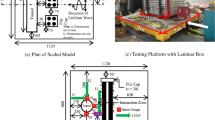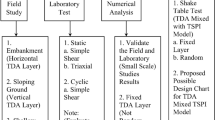Abstract
This paper presents the concrete tunnel-sand-pile interaction (TSPI) phenomenon in liquefiable sand considering various relative densities and seismic excitations. The novel shake table test for the TSPI model was performed to evaluate the excess pore pressure ratio (EPPR) surrounding the tunnel body and interactive tunnel and pile moments. The relative densities are taken to be 27, 41, and 55% in the local sand of Bangladesh. Similarly, the peak ground acceleration (PGA) of the Kobe and Loma Prieta earthquakes are considered to be 0.05, 0.10, 0.15, and 0.20 g. The shake table was calibrated based on similar variations of the input and output PGA. The 3D finite element concrete TSPI model has been performed by Plaxis considering the UBC3D-PLM (two yield surfaces consisting of kinematic hardening rules) constitutive model of sand. Therefore, experimental and numerical results vary closely, which may inform the possibility of the application of the concrete TSPI model on a large scale. The maximum SRSS (Square Root Sum of Squares) tunnel moment has been found to be 18.7 kN-m from the experimental results for 27% relative density of the Kobe earthquake with a PGA of 0.15 g. Also, the maximum SRSS moments of front and rear piles vary (0.10–0.14) % of the tunnel moment. So, the tunnel moment always shows a higher value in liquefiable ground based on the experimental results because of the larger volume and stiffness than a series of piles. However, the present study may be enhanced in the future by varying geometric properties.










Similar content being viewed by others
Data Availability
The datasets generated during and/or analysed during the current study are not publicly available due to some restriction but are available from the corresponding author on reasonable request.
References
An J et al (2021) A shaking table-based experimental study of seismic response of shield-enlarge-dig type’s underground subway station in liquefiable ground. Soil Dyn Earthq Eng 147:1–26. https://doi.org/10.1016/j.soildyn.2021.106621
Bao X et al (2017) Numerical analysis on the seismic behavior of a large metro subway tunnel in liquefiable ground. Tunn Undergr Space Technol 66:91–106. https://doi.org/10.1016/j.tust.2017.04.005
Beaty M, Byrne P (1998) An effective stress model for predicting liquefaction behaviour of sand. Geotech Earthq Eng Soild Dyn ASCE Geotech Spec Pub 75:766–777
Beaty M, Byrne P (2011) Ubcsand constitutive model. Itasca UDM website 904aR
Bhattacharya S, Madabhushi S, Bolton M (2004) An alternative mechanism of pile failure in liquefiable deposits during earthquakes. Ge´otechnique 54(3):203–213
Bolton M (1986) The strength and dilatancy of sands. Géotechnique 36(1):65–78
Finn W, Fujita N (2002) Piles in liquefiable soils: seismic analysis and design issues. Soil Dyn Earthq Eng 22:731–742
Hansen J (1970) A revised and extended formula for bearing capacity. Bulletin 28 Danish Geotechnical Institute Copenhagen
Haque F (2023) Numerically liquefaction analysis of tunnel-sand pile interaction (TSPI) under seismic excitation. Geomech Tunnell 16(2):193–204. https://doi.org/10.1002/geot.202200062
Hossain M, Ansary M (2018) Development of a portable traveling pluviator device and its performance to prepare uniform sand specimens. Innov Infrastruct Solut 3(1):1–12
Huded P, Dash S, Bhattacharya S (2022) Buckling analysis of pile foundation in liquefiable soil deposit with sandwiched non-liquefiable layer. Soil Dyn Earthq Eng 154:1–13
Hussein A, Naggar M (2021) Seismic axial behaviour of pile groups in non-liquefiable and liquefiable soils. Soil Dyn Earthq Eng 149:1–18
Iai S (1989) Similitude for shaking table tests on soil-structure-fluid model in 1g gravitational field. Soils Found 29(1):105–118
Liyanapathirana D, Poulos H (2002) A numerical model for dynamic soil liquefaction analysis. Soil Dyn Earthq Eng 22:1007–1015
Maheshwari B, Nath U, Ramasamy G (2008) Influence of liquefaction on pile-soil interaction in vertical vibration. ISET J Earthq Technol 45(1–2):1–12
Makra A (2013) Evaluation of the UBC3D-PLM constitutive model for prediction of earthquake induced liquefaction on embankment dams. Delft University of Technology. http://resolver.tudelft.nl/uuid:dfd7b8e4-8664-4026-bd3f-93749b72bfc8
Orang M et al (2021) An experimental evaluation of helical piles as a liquefaction-induced building settlement mitigation measure. Soil Dyn Earthq Eng 151:1–17
Petalas A, Galavi V (2012) Plaxis liquefaction model ubc3d-plm. PLAXIS knowledge base
Plaxis (2020) Material models manual. Bentley
Puebla H, Byrne M, Phillips P (1997) Analysis of canlex liquefaction embankments prototype and centrifuce models. Can Geotech J 34:641–657
Sahare A, Ueda K, Uzuoka R (2022) Influence of the sloping ground conditions and the subsequent shaking events on the pile group response subjected to kinematic interactions for a liquefiable sloping ground. Soil Dyn Earthq Eng 152:1–26
Schadlich B, Schweiger H (2014) A new constitutive model for shotcrete. Numerical Methods in Geotechnical Engineering, pp 103–108
Tang L et al (2021) Estimation of the critical buckling load of pile foundations during soil liquefaction. Soil Dyn Earthq Eng 146:1–11
Taylor E, Madabhushi S (2020) Remediation of liquefaction-induced floatation of non-circular tunnels. Tunn Undergr Space Technol 98:1–8
Tsegaye A (2010) Plaxis liquefaction model. Plaxis knowledge base
Wang R et al (2022) Influence of vertical ground motion on the seismic response of underground structures and underground-aboveground structure systems in liquefiable ground. Tunn Undergr Space Technol 122:1–12. https://doi.org/10.1016/j.tust.2021.104351
Yue F et al (2021) Shaking table test and numerical simulation on seismic performance of prefabricated corrugated steel utility tunnels on liquefiable ground. Soil Dyn Earthq Eng 141:1–18
Zhao K et al (2020) Stability of immersed tunnel in liquefiable seabed under wave loadings. Tunn Undergr Space Technol 102:1–13
Zhao K et al (2021) Seismic response of immersed tunnel in liquefiable seabed considering ocean environmental loads. Tunn Undergr Space Technol 115:1–14
Funding
The authors declare that no funds, grants, or other support were received during the preparation of this manuscript.
Author information
Authors and Affiliations
Corresponding author
Ethics declarations
Conflict of interests
The authors declare that they have no known competing financial interests or personal relationships that could have appeared to influence the work reported in this paper.
Additional information
Publisher's Note
Springer Nature remains neutral with regard to jurisdictional claims in published maps and institutional affiliations.
Rights and permissions
Springer Nature or its licensor (e.g. a society or other partner) holds exclusive rights to this article under a publishing agreement with the author(s) or other rightsholder(s); author self-archiving of the accepted manuscript version of this article is solely governed by the terms of such publishing agreement and applicable law.
About this article
Cite this article
Haque, M.F., Ansary, M.A. Liquefiable Concrete Tunnel–Sand–Pile Interaction Response Under Seismic Excitations. Geotech Geol Eng 42, 409–431 (2024). https://doi.org/10.1007/s10706-023-02580-9
Received:
Accepted:
Published:
Issue Date:
DOI: https://doi.org/10.1007/s10706-023-02580-9




